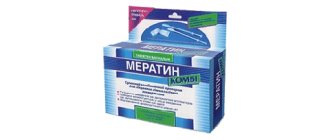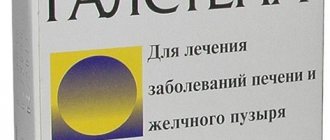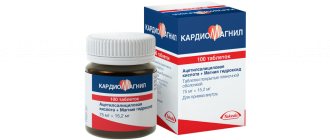Release form: Caplets, p/o, No. 12.
A combination of four active ingredients for maximum effectiveness. The proven formula quickly and permanently relieves fever, headache, cough, sore throat and poor health.
Manufacturer: Unimax Laboratories, India; Windlace Healthcare Pvt. Ltd., India; Mepro Pharmaceuticals PVT LTD, India.
Registration Certificate: No.UA/6458/01/01 Order of the Ministry of Health of Ukraine No. 429 dated 06/08/2012
Go to product website
Read Instructions
Find it in a pharmacy
Compound
1 tablet (caplet) of the drug Milistan Multisymptom includes 325 mg of paracetamol ; 15 mg dextromethorphan hydrobromide ; 10 mg cetirizine hydrochloride ; 2 mg chlorpheniramine maleate .
Additionally: corn starch, methylparaben, microcrystalline cellulose, propylparaben, magnesium stearate, sodium lauryl sulfate, talc, propylene glycol, colloidal silica, sodium starch glycolate (type A), polyethylene glycol 4000, hypromellose, titanium dioxide.
Composition of the drug:
Active ingredients: 1 caplet contains paracetamol 325 mg, cetirizine hydrochloride 10 mg, chlorpheniramine maleate 2 mg, dextromethorphan hydrobromide 15 mg.
Excipients: corn starch, microcrystalline cellulose, sodium methylparaben (E 219), sodium propylparaben (E 217), magnesium stearate, talc, colloidal silicon dioxide, sodium lauryl sulfate, sodium starch glycolate (type A), hypromellose, propylene glycol, polyethylene glycol 4000, titanium dioxide (E 171), purified water (removed during the production process).
Dosage form. Caplets covered with a membrane. White or almost white, oval-shaped, biconvex caplets, covered with a membrane, with a break line on one side.
Pharmacodynamics and pharmacokinetics
Milistan Multisymptom tablets are a combined medicinal product belonging to the group of analgesics and antipyretics , exhibiting the effects of all active ingredients included in its composition.
Paracetamol is known for its pronounced antipyretic, analgesic and anti-inflammatory effectiveness. The analgesic effect of paracetamol occurs due to the suppression of prostaglandin biosynthesis . Being a cyclogenase , the drug blocks the production of E2 and F2 prostaglandins , which play an important role in the transmission of pain stimuli by nociceptors impulses to the central nervous system . The peculiarity of the inhibitory effect of paracetamol on cyclooxygenase is that in the cells of the central nervous system it occurs much stronger than in peripheral tissues, leading to a virtual absence of negative effects on the processes of prostaglandin , thereby ensuring normal water-salt metabolism and proper functioning of the gastrointestinal mucosa. The antipyretic (antipyretic) activity of paracetamol becomes possible due to the inhibition of the biosynthesis of prostaglandins , which are mediators of the thermoregulation center , directly in the hypothalamus.
Cetirizine is a metabolic of hydroxyzine and is a selective peripheral H1 receptor . The main effect of this drug is aimed at preventing the formation and alleviating the course of existing allergic manifestations . Cetirizine also has antiexudative and antipruritic effectiveness. The antiallergic activity of the drug is achieved due to its ability to suppress the late stage of cell migration (mainly eosinophils ) that take part in inflammatory processes, as well as due to a decrease in the expression of adhesion molecules (VCAM-1, ICAM-1), which are allergic markers . Cetirizine inhibits the effects of other mediators and inducers of histamine secretion , such as substance P and PAF, and does not actually have an antiserotonin or anticholinergic effect. Reduces capillary permeability , prevents the formation of edema , and helps relieve spasm of smooth muscles . In therapeutic dosages it does not lead to a sedative effect .
Dextromethorphan is an antitussive drug that is particularly effective in the treatment of nonproductive (non-sputum-producing) bronchial cough . The effectiveness of this drug is associated with its inhibition of afferent impulses sent by the mucous membrane of the respiratory tract and an increase in the sensitive threshold of the cough center located in the medulla oblongata. When taking therapeutic dosages of dextromethorphan, there is no addiction , sedative and analgesic effects of the drug, as well as suppression of the work of the ciliated epithelium and respiration.
Chlorphenamine is an antiallergic drug from the group of H1 receptor blockers , which is characterized by antiallergic effectiveness manifested by vasoconstriction , decreased capillary permeability , elimination of hyperemia and swelling of the mucous membrane of the nasopharynx, nose and paranasal sinuses. Chlorphenamine reduces local exudative allergic rhinitis ( rhinorrhea , sneezing , itching of the nose, eyes, throat), and also has a moderate sedative effect .
In the digestive tract, the absorption of all active ingredients of Milistan tablets after oral administration occurs quite quickly and almost completely.
T1/2 of paracetamol varies between 1-3 hours. In patients suffering from liver cirrhosis , this parameter is slightly longer. The renal clearance of the drug is 5%. Excretion is carried out by the kidneys mainly in the form of sulfate and glucuronide conjugates.
T1/2 of cetirizine is approximately 10 hours. Excretion occurs through the kidneys (2/3 in unchanged form) and intestines (about 10% of the drug). Systemic clearance indicators are at the level of 53 ml/min.
T1/2 of dextromethorphan is approximately 4 hours. Excretion occurs in the urine in unchanged form and in the form of demethylated metabolic products (including dextrorphan).
The active ingredients of Milistan are able to cross the placenta and are found in breast milk .
Pharmacotherapeutic group.
Analgesics and antipyretics. Paracetamol in combination with other drugs (with the exception of psycholeptics).
ATS code Ї402В E51.
Paracetamol has analgesic, antipyretic, and anti-inflammatory effects. The mechanism of the analgesic effect of paracetamol is associated with inhibition of prostaglandin biosynthesis. By inhibiting cyclogenase, it prevents the formation of prostaglandins Er and B3, which play an important role in the perception of pain stimuli by nociceptors and the transmission of excitation to the central nervous system. Paracetamol inhibits cyclooxygenase more effectively in the cells of the central nervous system and much weaker in peripheral tissues. The lack of influence of paracetamol on the synthesis of prostaglandins in peripheral tissues determines the absence of its negative effect on water-salt metabolism and the mucous membrane of the gastrointestinal tract. The antipyretic effect of paracetamol is explained by inhibition of the biosynthesis of prostaglandins directly in the hypothalamus, which are mediators of the thermoregulation center.
Cetirizine hydrochloride is a selective antagonist of peripheral H1-histamine receptors, a metabolite of hydroxyzine. Prevents the development and facilitates the course of allergic reactions, has antipruritic and antiexudative effects. It causes an antiallergic effect due to inhibition of the late phase of migration of cells involved in the inflammatory reaction (mainly eosinophils) and also reduces the expression of adhesion molecules such as ISAM-1 and USAM-1, which are markers of allergic inflammation. Suppresses the effect of other mediators and inducers of histamine secretion, such as PAF (platelet-activating factor) and substance P. It has virtually no anticholinergic and antiserotonin effects. Reduces capillary permeability, prevents the development of tissue edema, relieves spasm of smooth muscles. It has virtually no anticholinergic and antiserotonin effects. In therapeutic doses it does not have a sedative effect.
Dextromethorphan hydrobromide is an antitussive drug effective for nonproductive bronchial cough. The mechanism of action is associated with the suppression of afferent impulses from the mucous membrane of the respiratory tract, increasing the sensitivity threshold of the cough center in the medulla oblongata. In therapeutic doses, dextromethorphan does not cause analgesic or sedative effects, and also does not depress respiration, is not addictive, and does not suppress the activity of the ciliated epithelium.
Chlorpheniramine maleate is an antiallergic drug, an H1 receptor blocker has an antiallergic effect, reduces capillary permeability, constricts blood vessels, eliminates swelling and hyperemia of the nasal mucosa, nasopharynx and paranasal sinuses; reduces local exudative manifestations, suppresses the symptoms of allergic rhinitis (sneezing, rhinorrhea, itching of the eyes, nose, throat). Causes a moderate sedative effect.
Suction. After oral administration, the drug is quickly and almost completely absorbed from the digestive tract.
Excretion. The half-life of paracetamol is 1-3 hours. In patients with liver cirrhosis, the half-life is prolonged. Binding to plasma and blood proteins is variable.
The renal clearance of paracetamol is 5%. It is excreted in the urine mainly in the form of glucuronide and sulfate conjugates.
After a single internal use of cetirizine hydrochloride, the half-life is approximately 10:00, 2/3 of the drug is excreted unchanged by the kidneys and about 10% in the feces. Systemic clearance - 53 ml / min.
The half-life of dextromethorphan hydrobromide is approximately 4 hours and the drug is excreted through the kidneys unchanged and in the form of demethylated metabolites (including dextrorphan). The active ingredients of the drug penetrate the placenta and into breast milk.
Indications for use
Prescription of Milistan Multisymptomatic is indicated for the purpose of symptomatic treatment of influenza and other acute respiratory viral infections , accompanied by high fever , irritating dry cough lacrimation , headaches , runny nose , muscle and joint pain, nasal congestion , including painful conditions with accompanying allergic manifestations .
Contraindications
The use of the drug is prohibited when:
- congenital hyperbilirubinemia ;
- pregnancy;
- glucose-6-phosphate dehydrogenase deficiency;
- personal hypersensitivity to any of the ingredients of the drug;
- severe pathologies of the liver / kidneys ;
- breastfeeding;
- blood diseases ;
- alcoholism;
- severe anemia ;
- intestinal obstruction;
- leukopenia;
- pyloroduodenal stenosis;
- hypocoagulation;
- arrhythmias;
- angle-closure glaucoma;
- epilepsy;
- hyperthyroidism;
- risk of urinary retention (due to diseases of the prostate and urethra);
- severe hypertension ;
- bladder outlet obstruction;
- pathologies of the cardiac coronary arteries;
- diabetes mellitus;
- risk of respiratory failure ;
- concurrent use of SSRIs and MAO inhibitors;
- up to 12 years old.
Side effects
Skin and mucous membranes:
- skin rashes (maculopapular, generalized, erythematous);
- rash on mucous membranes;
- angioedema;
- Stevens-Johnson syndrome;
- hives;
- erythema (multiform, drug-resistant);
- hyperemia;
- epidermal toxic necrolysis;
- itchy skin;
- vascular edema.
Gastrointestinal organs:
- heartburn;
- dyspeptic disorders;
- impaired liver function;
- nausea, vomiting;
- gastritis;
- abdominal pain;
- flatulence;
- dry mouth;
- increased levels enzymes ;
- diarrhea;
- hyperbilirubinemia;
- constipation;
- hepatotoxic effect (with prolonged use of high doses).
The immune system:
- reactions associated with personal hypersensitivity (including anaphylactic shock and anaphylaxis ).
Endocrine system:
- hypoglycemia (possible development of hypoglycemic coma).
Respiratory system:
- rhinitis;
- pharyngitis;
- nasal congestion;
- bronchospasm (with sensitivity to NSAIDs).
Hematopoietic system:
- anemia (including hemolytic and aplastic);
- thrombocytopenia;
- methemoglobinemia and sulfhemoglobinemia (shortness of breath, cyanosis, heart pain);
- agranulocytosis;
- leukopenia.
Nervous system:
- paradoxical stimulation of the central nervous system;
- dizziness;
- dysgeusia;
- headache;
- euphoria;
- convulsions;
- excitation;
- vertigo;
- sedative effect;
- paresthesia;
- movement disorders;
- nervousness;
- noise in ears;
- fainting;
- neurosis;
- drowsiness / insomnia ;
- dystonia;
- depression;
- neuritis;
- dyskinesia;
- aggression;
- lack of coordination;
- acute labyrinthitis;
- irritability;
- increased fatigue;
- nervous tic;
- coma;
- confusion;
- behavior changes;
- anxiety;
- tremor;
- hallucinations.
Urinary system:
- urinary retention;
- dysuria;
- difficulty urinating;
- enuresis.
Organs of vision:
- double vision;
- mydriasis;
- disturbance of accommodation;
- photophobia;
- blurred vision;
- increased intraocular pressure ;
- decreased visual acuity;
- fogging;
- involuntary eye movements.
The cardiovascular system:
- cardiopalmus ; _
- tachycardia;
- blood pressure fluctuations ;
- arrhythmia.
Reproductive system:
- impotence;
- menstruation disorders.
Are common:
- increased fatigue;
- asthenia;
- malaise;
- swelling.
Other:
- dry mucous membranes;
- weight gain;
- hyperhidrosis.
Milistan multisymptomatic suspension - instructions, composition, dosage, side effects of use
Milistan multisymptomatic suspension
Milistan multisymptomic suspension (Suspensio Milistan multisymptomic)
Main physical and chemical characteristics : pink suspension;
Compound. every 5 ml of suspension contains paracetamol 160 mg, cetirizine hydrochloride 2.5 mg, chlorpheniramine maleate 1 mg, dextromethorphan hydrobromide 5 mg;
other ingredients: sodium methylparaben, sodium propylparaben, sodium carboxymethylcellulose, disodium edetate, xanthan gum, sorbitol solution 70%, colored carmoisin supra, sucrose, mixed fruit essence, purified water.
Release form of the medicinal product. Suspension for oral use.
Pharmacotherapeutic group. Analgesics-antipyretics. Paracetamol in combination with other drugs (with the exception of psycholeptics). ATC code N02B E51.
Action of the medicine.
Pharmacodynamics. Paracetamol has analgesic, antipyretic and mild anti-inflammatory effects. The mechanism of action is associated with inhibition of prostaglandin synthesis and a predominant effect on the thermoregulation center in the hypothalamus.
Cetirizine hydrochloride is a selective antagonist of peripheral H1-histamine receptors, a metabolite of hydroxyzine. It has antiallergic properties due to inhibition of the late phase of migration of cells that participate in the inflammatory response (mainly eosinophils); also reduces the expression of adhesion molecules such as ICAM-1 and VCAM-1, which are markers of allergic inflammation. Suppresses the effect of other mediators and inducers of histamine secretion, such as PAF (platelet-activating factor) and substance P. It has virtually no anticholinergic and antiserotonin effects. In therapeutic doses it does not produce a sedative effect.
Dextromethorphan hydrobromide is an antitussive drug that is effective for non-productive bronchial cough, which occurs through irritation of the bronchi when inhaling cold air. The mechanism of action is associated with the influence on the cough center in the medulla oblongata.
Chlorpheniramine maleate is an antiallergic drug, a blocker of histamine H1 receptors. Causes a moderate sedative effect;
Desoxycorticosteroniacetas (Deoxycorticosterone acetate) instructions for use and description of the medicine.
Pharmacokinetics. Suction. After internal use, the drug is quickly and almost completely absorbed from the digestive tract.
Using the drug simultaneously with food does not affect absorption, but slightly reduces the rate.
Distribution. Paracetamol is well distributed in tissues (with the exception of adipose tissue) and cerebrospinal fluid. The binding of paracetamol to plasma proteins is approximately 10% and increases slightly with overdose. Cetirizine is also able to bind to plasma proteins. It has a low volume of distribution (Vd – 0.5 l/kg), does not penetrate into the cell.
Metabolism. Paracetamol is metabolized primarily in the liver by conjugation with glucuronide, sulfate and oxidation involving mixed liver oxidases and cytochrome P450. Cetirizine is practically not metabolized in the liver. Dextromethorphan hydrobromide is rapidly and almost completely metabolized in the liver to the active metabolite dextrorphan.
Excretion. The half-life of paracetamol is 1-3 hours. In patients with liver cirrhosis, the half-life is prolonged. The renal clearance of paracetamol is 5%. It is excreted in the urine mainly in the form of glucuronide and sulfate conjugates. Less than 5% is excreted as unchanged paracetamol. The drug is excreted in breast milk. After a single internal use of cyterizine hydrochloride, its half-life is approximately 10 hours. The half-life of dextromethorphan hydrobromide is almost 4 hours. , the drug is excreted through the kidneys unchanged and in the form of demethylated metabolites (including dextrorphan). The active ingredients of the drug penetrate the placenta and are excreted in breast milk.
Indications for use.
Symptomatic treatment of influenza and other acute respiratory viral infections, which are accompanied by fever, muscle and joint pain, headache, nasal congestion, runny nose, lacrimation, childhood infections, post-vaccination reactions, teething; hay fever, allergic rhinitis and other allergic diseases of the upper respiratory tract, accompanied by the above symptoms; pain syndrome of low and medium intensity of various origins (main, toothache, migraine, neuralgia, myalgia, menalgia, pain from injuries, burns), diarrhea in infectious and inflammatory diseases, dry irritated cough.
Vaskopin - instructions, composition, dosage, side effects of use
Method of use and dose.
Children aged 1 to 3 years: 1 measuring spoon 3 times a day;
children aged 3 to 6 years: 1 measuring spoon 4 times a day;
children over 6 years old: 2 scoops 3 – 4 times a day.
Maximum duration of treatment: 5 – 7 days.
The interval between doses should be at least 4 hours. Do not use more than 4 times a day!
Side effect.
In isolated cases, as a rule, due to prolonged use of large doses, drowsiness, sleep disturbance, increased excitability, pain in the epigastric region, nausea, toxic effects on the liver (due to paracetamol) may be observed; skin itching, skin rashes, Quincke's edema, anemia, thrombocytopenia; dry mouth, difficulty urinating, impaired accommodation, increased intraocular pressure (due to the anticholinergic effect of chlorpheniramine).
Restrictions and contraindications in the use of the drug.
Hypersensitivity to the components of the drug, chronic alcoholism, severe liver and/or kidney dysfunction, deficiency of the enzyme glucose-6-phosphate dehydrogenase, blood diseases, children under 1 year of age, pregnancy, breastfeeding.
Exceeding the permissible dose of the drug (overdose).
Symptoms: possible sleep disturbance, itching, rashes, urinary retention, fatigue, tremor, tachycardia.
Holevid instructions for use and description of the medicine.
Treatment: symptomatic therapy. Hemodialysis is ineffective.
Features of use.
Pregnancy and lactation. The use of the drug Milistan multisymptomatic during pregnancy is possible only in cases where the predicted benefit to the mother outweighs the potential risk to the fetus. It is advisable to refrain from using the drug during lactation or the issue of stopping breastfeeding should be resolved (the drug can pass into breast milk).
Use with caution in patients with dysfunction of the liver, digestive tract and kidneys, with benign hyperbilirubinemia, closed-angle glaucoma, prostatic hypertrophy, epilepsy, urinary retention, severe cardiovascular diseases, diabetes mellitus, bronchial asthma, productive cough, as well as in elderly patients age. With long-term use of the drug, it is necessary to monitor peripheral blood and the functional state of the liver (once every 10 days).
While using the drug, you should avoid driving vehicles, operating machinery and other potentially unsafe activities.
Do not drink alcohol while using the drug!
Interaction with other drugs . When used simultaneously with barbiturates, anticonvulsants, rifampicin and alcohol, the risk of hepatotoxicity increases significantly.
With the simultaneous use of Milistan multisymptomatic with metoclopramide, it is possible to increase the absorption of paracetamol.
With the simultaneous use of Milistan multisymptomatic and coumarin derivatives, slight hypoprothrombinemia may develop.
Caffeine may potentiate the analgesic effect of paracetamol.
Features of conditions, shelf life and sales..
Keep at room temperature (15-25 °C) in a place protected from light and out of reach of children.
Shelf life – 2 years.
Milistan, instructions for use
Patients over 12 years of age are recommended to take Milistan Multisymptomatic orally (inside), 1 caplet (tablet) once every 24 hours. The duration of the therapeutic course for adult patients should be limited to 7 days; at the age of 12-18 years – 3 days.
For moderately severe renal pathologies, tablets are taken in half the dose.
In old age there is no need to adjust the dosage regimen.
Caplets Milistan
Instructions for medical use of the drug
Description of pharmacological action
Combined drug. It contains analgesic, antitussive and antihistamine agents. The action of the non-narcotic analgesic paracetamol is due to the blocking of cyclooxygenase in the central nervous system. It has pronounced analgesic and antipyretic effects. The anti-inflammatory effect of paracetamol is slightly expressed.
Indications for use
— Symptoms of the acute period of ARVI or influenza (headache, rhinorrhea, myalgia, lacrimation, nasal congestion, arthralgia, fever); - allergic rhinitis, hay fever; - moderate and mild pain syndrome; - whooping cough; - reflex and spasmodic cough.
Release form
Caplets, p/o, No. 12.
Pharmacodynamics
Chlorpheniramine blocks histamine H1 receptors. As a result of its action, the manifestations of allergic reactions become weaker, local swelling and exudation decrease. Along with the antihistamine, chlorpheniramine has a sedative, anticholinergic and antiserotonin effect. Absorbed slowly in the digestive tract. Most of the ingested substance is methylated in the liver. Excretion of chlorpheniramine and its metabolites is carried out mainly by the kidneys. Dextromethorphan is a centrally acting antitussive drug. Opioid analgesic of synthetic origin. Inhibits the neurons of the cough center. It has virtually no analgesic or hypnotic effect. Addiction to the drug does not develop. In the digestive tract, dextromethorphan is absorbed quite quickly and completely. Partially excreted by the kidneys, partially biotransformed in the liver.
Pharmacokinetics
Absorption of paracetamol occurs in the small intestine. Most of it undergoes conjugation in the liver. Conjugates and small amounts of paracetamol are excreted by the kidneys. Cetirizine causes blockade of peripheral histamine receptors. Acts as an antiallergic agent that practically does not cause antiserotonin, anticholinergic and sedative effects. Absorbed quickly in the digestive tract. Partially dealkylated in the liver, resulting in the formation of an inactive metabolite. The bulk of the administered dose is excreted in the urine, approximately 10% in feces.
Use during pregnancy
Contraindicated.
Contraindications for use
Chronic alcoholism, pregnancy, hypersensitivity, lactation, blood diseases, severe kidney or liver diseases, glucose-6-phosphate dehydrogenase deficiency. Caution is required when prescribing to patients with glaucoma, epilepsy, severe heart disease, urinary retention, diabetes mellitus, and bronchial asthma.
Side effects
— Sleep disorders; - drowsiness; - epigastric pain; - nausea; - skin itching; - allergic reactions; - hepatopathy; - thrombocytopenia; - anemia; - dysuric phenomena; — disturbances of accommodation; - increased intraocular pressure.
Directions for use and doses
Milistan in caplets is recommended for use from the age of twelve. A single dose is one caplet (maximum is two caplets). A daily dose of up to four times is allowed. The recommended duration of use is no more than seven days. For moderate or severe renal failure, Milistan is prescribed at half the dose.
Overdose
Dizziness, urinary retention, disturbances of consciousness, respiratory depression, tremor, tachycardia, ataxia, decreased blood pressure. Therapy is symptomatic. In case of severe breathing problems - mechanical ventilation.
Interactions with other drugs
The hepatotoxic effect of the drug can be enhanced by rifampicin, barbiturates, alcohol and anticonvulsants. The analgesic effect of paracetamol is potentiated by caffeine. Metoclopramide increases the absorption of paracetamol. Concomitant use with coumarin derivatives may cause minor hypoprothrombinemia. Chlorpheniramine interferes with the metabolism of diphenine in the liver.
Storage conditions
Room temperature, protected from light.
Best before date
12 months
Overdose
Due to possible liver damage , if you take excessive doses of the drug, you should contact your doctor.
The dosage of paracetamol that can potentially cause liver damage in an adult patient is considered to be a dose of 10 grams or more; in children – 150 mg per kilogram of weight. This dosage is halved (to 5 grams) for adult patients with any risk factors (including alcohol abuse , cachexia, cystic fibrosis , hunger strike, HIV infection , digestive disorders, long-term therapy with Phenobarbital , Carbamazepine , Phenytoin , Rifampicin , Primidone , drugs St. John's wort or other drugs that induce liver enzymes).
In the first 24 hours, the following symptoms of overdose were observed: loss of appetite , pallor , nausea / vomiting , abdominal pain. Liver damage itself appears within 12-48 hours after the first symptoms of overdose. It is also possible to develop metabolic acidosis and glucose metabolism .
In case of intoxication , liver failure can develop into hemorrhage, encephalopathy , hypoglycemia , coma , cerebral edema and result in death .
In acute renal failure with tubular necrosis, which can develop even without symptoms of liver damage , severe pain in the lumbar region, proteinuria and hematuria .
Other manifestations of an overdose can be expressed: renal colic , cardiac arrhythmia , papillary necrosis , tachycardia , interstitial nephritis , sleep impairment, urination delay , tachypnoe , dizziness , pancreatitis , headaches , drowsiness , psychomotor excitation , orientation , rash/imperial impaired, increased rash , increased fatigue, confusion malaise , anxiety, mydriasis , stupor , respiratory depression, ataxia , diplopia , hepatonecrosis, convulsions .
With prolonged use of high dosages of the drug, the hematopoietic system may cause leukopenia , aplastic anemia, agranulocytosis , pancytopenia , neutropenia, thrombocytopenia .
In case of reasonable suspicion of overdose, all measures should be taken to provide emergency medical assistance. The patient must be immediately taken to a specialized medical facility even in the absence of early severe symptoms, since sometimes the external manifestations of this condition may be limited to nausea / vomiting or may not reflect the full severity of negative internal pathological processes.
If an overdose of the drug is observed within 60 minutes, Activated Charcoal .
Plasma concentrations of paracetamol should be monitored 4 hours after an overdose or later, since early indicators of its level may be unreliable.
Taking the antidote - Acetylcysteine - is advisable throughout the day after an overdose of paracetamol (maximum effectiveness is observed within 8 hours).
In the absence of vomiting, Methionine can be prescribed orally (alternative help if a medical facility is not available).
Subsequently, treatment is carried out according to the observed symptoms.
Pulmibud
With long-term use of any inhaled glucocorticosteroids, especially in high doses, systemic effects may be observed, but the likelihood of their development is much lower than when taking glucocorticosteroids orally.
Possible systemic effects include Cushing's syndrome, Cushingoid symptoms, adrenal suppression, decreased bone mineral density, growth retardation in children and adolescents, cataracts, glaucoma, psychological and behavioral disturbances. Therefore, it is especially important that when a therapeutic effect is achieved, the dose of inhaled glucocorticosteroids is reduced to the minimum effective dose to control the course of the disease.
Visual impairment has been reported with systemic and local use of glucocorticosteroids. If a patient experiences symptoms such as blurred vision or other visual disturbances, consider referring the patient to an ophthalmologist to evaluate possible causes, which may include cataracts, glaucoma, or rare diseases such as central serous chorioretinopathy.
An increased incidence of pneumonia has been reported in patients with COPD treated with inhaled corticosteroids. There was no difference in the incidence of this side effect when using different glucocorticosteroids, thus, this adverse reaction is “class-specific” for all inhaled glucocorticosteroids when prescribed to patients with COPD.
Additional risk factors for developing pneumonia include smoking, older age, low body mass index, and severity of COPD symptoms. To minimize the risk of fungal infection of the oropharynx, the patient should be instructed to thoroughly rinse the mouth with water after each inhalation of the drug.
Co-administration of budesonide with ketoconazole, itraconazole or other potential inhibitors of the CYP3A4 isoenzyme should be avoided. If budesonide and ketoconazole or other potential inhibitors of the CYP3A4 isoenzyme have been prescribed, the time between doses should be increased to the maximum possible.
Due to the possible risk of weakening adrenal function, special attention should be paid to patients who are switching from oral glucocorticosteroids to taking Pulmibud.
Also, special attention should be paid to patients taking high doses of glucocorticosteroids, or who have been receiving the highest recommended doses of inhaled glucocorticosteroids for a long time.
In stressful situations, these patients may exhibit signs and symptoms of adrenal insufficiency. In case of stress or in case of surgery, additional therapy with systemic glucocorticosteroids is recommended.
Particular attention should be paid to patients who are transferred from systemic to inhaled glucocorticosteroids (Pulmibud) or in cases where a violation of the pituitary-adrenal function can be expected. In such patients, the dose of systemic glucocorticosteroids should be reduced with extreme caution and hypothalamic-pituitary-adrenal function should be monitored. Patients may also require the addition of oral corticosteroids during stressful situations such as trauma, surgery, etc.
When switching from oral glucocorticosteroids to Pulmibud, patients may experience previously observed symptoms, such as muscle pain or joint pain. In such cases, a temporary increase in the dose of oral corticosteroids may be necessary. In rare cases, symptoms such as fatigue, headache, nausea and vomiting may occur, indicating systemic glucocorticosteroid deficiency.
Replacing oral glucocorticosteroids with inhaled ones sometimes leads to the development of concomitant allergies, for example, rhinitis and eczema, which were previously treated with systemic drugs.
In children and adolescents receiving treatment with glucocorticosteroids (regardless of the method of delivery) for an extended period, it is recommended to regularly monitor growth parameters. When prescribing glucocorticosteroids, the balance between the benefits of using the drug and the possible risk of growth retardation should be taken into account.
The use of budesonide at a dose of up to 400 mcg per day in children over 3 years of age did not lead to systemic effects. Biochemical signs of a systemic effect of the drug may occur when taking the drug at a dose of 400 to 800 mcg per day. When the dose exceeds 800 mcg per day, systemic effects of the drug are common.
The use of glucocorticosteroids for the treatment of bronchial asthma may cause growth impairment. The results of observations of children and adolescents receiving budesonide for a long period (up to 11 years) showed that the growth of patients reaches the expected normative indicators for adults.
Therapy with inhaled budesonide 1 or 2 times a day has shown effectiveness for the prevention of bronchial asthma due to physical exertion.
Interaction
The absorption of paracetamol is enhanced by the concomitant use of Domperidone and Metoclopramide and reduced by the concomitant use of Cholestyramine .
In the case of long-term combined use of paracetamol with Warfarin and other coumarins , an increase in their anticoagulant effect was observed with an increase in the possibility of bleeding .
The combined use of barbiturates with paracetamol may adversely affect its antipyretic effectiveness.
Anticonvulsants ( Phenytoin , Carbamazepine ), barbiturates, Isoniazid , Rifampicin and ethanol can increase the toxic effect of paracetamol on the liver.
The effectiveness of diuretics is reduced when taking paracetamol .
Taking the drug with food reduces the rate of absorption of Cetirizine , but does not affect its extent.
Ethanol and drugs that depress the central nervous system can enhance the inhibitory effect of Chlorpheniramine , which increases the possibility of overdose.
Maprotiline , tricyclic antidepressants and other anticholinergic medications may increase the anticholinergic effectiveness of chlorpheniramine . With this combination of drugs and the discovery of negative gastrointestinal side effects in the patient, the formation of paralytic intestinal obstruction .
Caffeine increases the analgesic effects of paracetamol .
Photosensitizing drugs may cause an additional risk of photosensitizing effects.
Taking ototoxic medications may mask possible symptoms of ototoxicity, including dizziness , tinnitus , and fainting .
Milistan should not be used in conjunction with antitussives that suppress the cough reflex ( Codeine ), as this complicates the expectoration .
special instructions
If a patient is diagnosed with pathologies of liver or kidney function , before taking Milistan it is necessary to consult with the appropriate doctors.
In patients with cachexia taking paracetamol , the risk of developing metabolic acidosis . Symptoms of this painful condition are expressed by loss of appetite , rapid, deep difficulty breathing , nausea/vomiting. Before starting to take Milistan caplets, patients with severe infections that increase the risk of metabolic acidosis should consult a doctor.
Patients with alcoholic liver damage are more susceptible to the hepatotoxic effects of paracetamol .
Milistan may alter laboratory results, particularly with regard to plasma uric acid and glucose .
Elderly patients at risk of developing convulsive seizures , patients with bronchial asthma and with chronic or persistent cough caused by asthma , smoking , emphysema , accompanied by excessive secretion, Milistan should be prescribed with extreme caution.
Concomitant use of drugs including paracetamol .
In case of persistent headaches , you should consult your doctor.
With prolonged use of Milistan, it is necessary to monitor the functionality of the liver / kidneys , as well as monitor the hematopoietic function .
During therapy you should not take sedatives .
When treating a painful condition caused by a bacterial infection antibiotic therapy should be considered .
If, when taking Milistan Multisymptomatic, the formation of skin rashes is observed, as well as the development of hemolytic drug-induced anemia or hemolysis of red blood cells , treatment is stopped.
You should not take the drug if you have previous respiratory problems while taking NSAIDs.
Appropriate safety precautions for use.
It should be taken into account that in patients with alcoholic non-cirotic liver damage, the risk of hepatotoxic action of paracetamol increases; the drug may affect the results of laboratory tests on the levels of glucose and uric acid in the blood.
Prescribe the drug with caution to elderly patients, patients at risk of seizures, patients with bronchial asthma, persistent or chronic cough that occurs as a result of smoking, asthma or emphysema, when the cough is accompanied by excess secretion. Do not exceed the indicated doses. Do not take the drug simultaneously with other products containing paracetamol. If the headache becomes persistent, you should consult a doctor. With long-term use, it is necessary to monitor the function of the liver, kidneys, and the state of the hematopoietic system. If symptoms do not go away, you should consult a doctor.
During treatment, do not use sedatives (especially barbiturates), which increase the sedative effect of antihistamines (chlorpheniramine maleate).
If the disease is caused by a bacterial infection, concurrent treatment with antibiotics is recommended.
If hemolysis of red blood cells or drug-induced hemolytic anemia occurs during the use of the drug Milistan multisymptomatic, the drug should be discontinued immediately. If skin rashes occur, use of the drug should be discontinued.
Do not drink alcohol while using the drug!
Analogs
Level 4 ATC code matches:
Phenacetin
Combiflu
Chlorphenamine
Coldflu
Calpol
Fervex
Panadol Extra
Panadol for children
Panadol
Solpadeine
Efferalgan
Coldrex Maxgripp
Coldrex Hotrem
Coldrex
AntiGrippin
Unispaz
Pentalgin Plus
Rapidol
Maxicold
Perfalgan
Medicinal products with a similar main effect are:
- Adzhikold;
- Gripout;
- Glycodin;
- Coldrin;
- Neogrip;
- Lorcold;
- Maxicold;
- Amicitron;
- Flukold;
- Vicks Active;
- Teraflu;
- Antigrippin;
- Pharmacitron , etc.
Medicines from its product line are also considered analogues of the drug: Milistan for cough ; Milistan syrup ; Milistan sine ; Milistan hot drink .
Reviews
Provided the dosage regimen is followed and there are no contraindications, reviews of Milistan Multisymptom in the vast majority of cases are positive. The combination of active ingredients of this drug really leads to quick and lasting relief from the negative symptoms of influenza and ARVI and most often does not cause any side effects. Naturally, Milistan should not be abused, nor should it be taken in increased dosages, as this could potentially lead to serious adverse consequences.
Similar drugs:
- Serrata Oral tablets
- Ibufen Oral suspension
- Meloflex Rompharm Solution for intramuscular administration
- Dollar () Oral tablets
- Ketanov Oral tablets
- Synmeton (SYNMETON) Oral tablets
- Novalgin Oral tablets
- Spasmalin Solution for injection
- Aspirin Oral tablets
- Incena Capsule
** The Drug Directory is intended for informational purposes only. For more complete information, please refer to the manufacturer's instructions. Do not self-medicate; Before starting to use the drug Milistan, you should consult a doctor. EUROLAB is not responsible for the consequences caused by the use of information posted on the portal. Any information on the site does not replace medical advice and cannot serve as a guarantee of the positive effect of the drug.
Are you interested in the drug Milistan? Do you want to know more detailed information or do you need a doctor's examination? Or do you need an inspection? You can make an appointment with a doctor - the Euro lab is always at your service! The best doctors will examine you, advise you, provide the necessary assistance and make a diagnosis. You can also call a doctor at home . Euro lab clinic is open for you around the clock.
** Attention! The information presented in this medication guide is intended for medical professionals and should not be used as a basis for self-medication. The description of the drug Milistan is provided for informational purposes and is not intended for prescribing treatment without the participation of a doctor. Patients need to consult a specialist!
If you are interested in any other drugs and medications, their descriptions and instructions for use, information about the composition and form of release, indications for use and side effects, methods of use, prices and reviews of drugs, or you have any other questions and suggestions - write to us, we will definitely try to help you.
Price, where to buy
The price of Milistan Multisymptom fluctuates around 70-90 hryvnia.
- Online pharmacies in RussiaRussia
- Online pharmacies in UkraineUkraine
LuxPharma* special offer
- Milistan multisymptomatic caplets N12
RUB 1,480 order
show more
Pharmacy24
- Milistan multisymptomatic 100 ml suspension Grakure Pharmaceuticals LTD, India
76 UAH.order - Milistan multisymptomatic No. 12 capsules Mepro Pharmasyut.PVT.LTD..India/Windlas Healthcare Pvt.Ltd..India
71 UAH order
- Milistan for cough No. 20 tablets Mepro Pharmaceuticals Private Limited, India
79 UAH order









